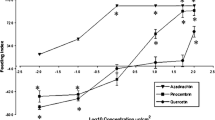Abstract
Bioassay responses inCotesia marginiventris (Cresson) females to materials derived from fall armyworm (FAW) larvae,Spodoptera frugiperda (J. E. Smith), were most intense for frass and somewhat less intense for larval and pupal cutical materials, scales, exuviae, silk, and oral secretion, with FAW larval hemolymph eliciting only a slight response. The highest percentage of ovipositor probing was caused by frass (100%) and moth scales (90%). Various types of corn-leaf damage when assayed alone did not produce responses as intense as when assayed in combination with frass, cuticle material, and oral secretion. Parasitoid response was somewhat better to frass derived from FAW larvae feeding on corn and peanut leaves than from larvae feeding on the foliage of soybeans, Bermuda grass, cowpeas, or laboratory diet. Hexane and chloroform were better than methanol and water for extracting active material from FAW frass, and chloroform was the best of these solvents for extracting corn leaves. Serial dilutions of frass extracts resulted in a reduction in parasitoid response.
Similar content being viewed by others
References
Ashley, T.R. 1979. Classification and distribution of fall armyworm parasites.Fla. Entomol. 62:114–123.
Baker, J. E. andNelson, D. R. 1981. Cuticular hydrocarbons of adults of cowpea weevil,Calloso-bruchus maculatus.J. Chem. Ecol 7:175–182.
Boling, J.C., andPitre, H.N. 1970. Life history ofApanteles marginiventris with descriptions of immature stages.J. Kans. Entomol. Soc. 43:465–470.
Jones, R.L., Lewis, W.J., Brown, M.C., Beroza, M., andBierl, B.A. 1971. Host-seeking stimulant for parasite of corn earworm: Isolation, identification and synthesis.Science 173:842–843.
Jones, R.L., Lewis, W.J., Beroza, M., andSparks, A.N. 1973. Host-seeking stimulants (kairomones) for the egg parasite,Trichogramma evanescens.Environ. Entomol. 2:593–596.
Jones, R.L., Lewis, W.J., Gross, H.R., Jr., andNordlund, D.A. 1976. Use of kairomones to promote action by beneficial insect parasites, pp. 119–134,in Pest Management with Insect Sex Attractants and Other Behavior-Controlling Chemicals. American Chemical Society, Washington, D.C.
King, E.G., andLeppla, N.C. (eds.) 1983. Advances in Insect Rearing. U.S. Dept. Agr. Tech. Bull, (in press).
Laing, J. 1937. Host finding by insect parasites. I. Observations on the finding of hosts byAlysia manducator, Mormoniella vitripennis andTrichogramma evanescens.J. Anim. Ecol. 6:298–317.
Leonard, D.E. Bierl, B.A., andBeroza, M. 1975. Gypsy moth kairmones influencing behavior of the parasitoidsBrachymeria intermedia andApanteles melanoscelus.Environ. Entomol. 4:926–930.
Lewis, W.J., andJones, R.L. 1971. Substance that stimulates host-seeking byMicroplitis croceipes (Hymenoptera: Braconidae), a parasite ofHeliothis sp.Ann. Entomol. Soc. Am. 64:471–473.
Lewis, W.J., Jones, R.L., Gross, H.H., Jr., andNordlund, D.A. 1976. The role of kairomones and other behavioral chemicals in host finding by parasitic insects.Behav. Biol. 16:267–289.
Loke, W.H. Ashley, T.R., andSailer, R.I. 1983. Influence of fall armyworm,Spodoptera frugiperda (Lepidoptera: Noctuidae), larvae and corn plant damage on host finding inApanteles marginiventris (Hymenoptera: Braconidae).Environ. Entomol. 12:911–915.
Mueller, A.J., andKunnalacca, S. 1979. Parasites of green cloverworm on soybean in Arkansas.Environ. Entomol. 8:376–379.
Nickle, D.A. 1977. The peanut agroecosystem in Central Florida: Economic thresholds for defoliating noctuids (Lepidoptera, Noctuidae); Associated parasites; Hyperparasitism of theApanteles complex (Hymenoptera, Braconidae), Ph.D. dissertation. University of Florida, Gainesville. 131 pp.
Richards, G. 1978. The chemistry of insect cuticle, pp. 205–232,in M. Rockstein (ed.). Biochemistry of Insects. Academic Press, New York.
Sato, Y. 1979. Experimental studies on parasitization byApanteles glomeratus. IV. Factors leading a female to the host.Physiol Entomol. 4:63–70.
Sauls, C.E., Nordlund, D. A., andLewis, W. J. 1979. Kairomones and their use for management of entomophagous insects. VIII. Effect of diet on the kairomonal activity of frass fromHeliothis zea (Boddie) larvae forMicroplitis croceipes (Cresson).J. Chem. Ecol. 5:363–369.
Thorpe, W.H., andJones, F.G.W. 1937. Olfactory conditioning in a parasite insect and its relation to the problem of host selection.Proc. Roy. Entomol. Soc. London Ser. B 124:56–81.
Vinson, S.B. 1968. Source of a substance inHeliothis virescens (Lepidoptera: Noctuidae) that elicits a searching response in its habitual parasiteCardiochiles nigriceps (Hymenoptera: Braconidae).Ann. Entomol. Soc. Am. 61:8–10.
Vinson, S.B. 1977. Behavioral chemicals in the augmentation of natural enemies, pp. 237–279,in R.L. Ridgway and S.B. Vinson (eds.). Biological Control by Augmentation of Natural Enemies; Insect and Mite Control with Parasites and Predators. Plenum Press, New York.
Vinson, S.B., andLewis, W.J. 1965. A method of host selection byCardiochiles nigriceps, a parasitoid for tobacco budworm.Entomol. Exp. Appl. 18:443–450.
Vinson, S.B., Jones, R.L., Sonnet, P.E., Bierl, B.A., andBeroza, M. 1975. Isolation, identification and synthesis of host-seeking budworm.Entomol. Exp. Appl. 18:443–450.
Weseloh, R.M. 1981. Host location by parasitoids, pp. 79–95,in D.A. Nordlund, R.L. Jones, and W.J. Lewis (eds.). Semiochemicals: Their Role in Pest Control. John Wiley & Sons, New York.
Author information
Authors and Affiliations
Additional information
This paper was submitted in partial fulfillment of the requirements for Doctor of Philosophy, Department of Entomology and Nematology, University of Florida, Gainesville.
Rights and permissions
About this article
Cite this article
Loke, W.H., Ashley, T.R. Sources of fall armyworm,Spodoptera frugiperda (Lepidoptera: Noctuidae), kairomones eliciting host-finding behavior inCotesia (=Apanteles) marginivenitris (Hymenoptera: Braconidae). J Chem Ecol 10, 1019–1027 (1984). https://doi.org/10.1007/BF00987510
Received:
Revised:
Issue Date:
DOI: https://doi.org/10.1007/BF00987510




